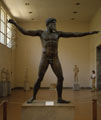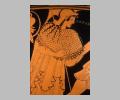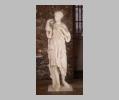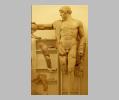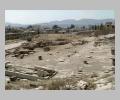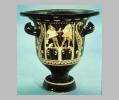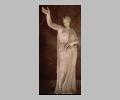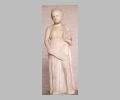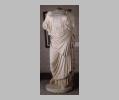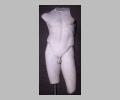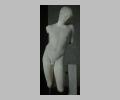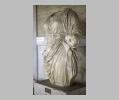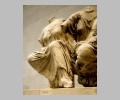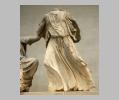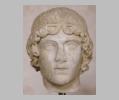Athenian Religious and Cultural Life in the Golden Age
Unprecedented changes occurred in many areas of the lives of the Athenians in the Golden
Age, but at the same time central aspects of Athenian society remained unchanged. The
result was a mix of innovation and continuity. The most conspicuous continuity was in
traditional Greek religion, which permeated public and private life. For most people,
their religious beliefs and practices remained largely the same as they had always been.
One of the most striking cultural changes of the period, on the other hand, come with the
development of tragic drama as a publicly supported art form performed before mass
audiences. Artists as well as dramatists were experimenting with new techniques and
approaches in this period, too, and artistic developments in
free-standing
sculpture1 provide the clearest demonstration of the innovation and variety
in the depiction of the human form that characterized Greek art in the fifth century.
The Outlines of Greek Religion in the Classical Period
The Athenians' attitude in the mid-fifth century B.C. about their fortunate
relationship to the gods corresponded to the basic tenet of traditional Greek religion:
humans both as individuals and as groups
paid honors to the gods2 to thank them for blessings received
and to receive blessings in return. Those honors consisted of sacrifices, gifts to the
gods' sanctuaries, and festivals of songs, dances, prayers, and processions. A
seventh-century B.C. bronze statuette, now in the Boston Museum of Fine Arts, which a
man named Mantiklos gave to a (now unknown) sanctuary of Apollo to honor the god, makes
clear why individuals gave such gifts. On the statuette's legs Mantiklos inscribed his
understanding of the transaction: “Mantiklos gave this from his share to the
Far Darter of the Silver Bow [i.e., Apollo]; now you, Apollo, do something for me in
return.” This idea of reciprocity between gods and humans underlay the Greek
understanding of the divine. Gods did not love human beings, except sometimes literally
in mythological stories of gods taking earthly lovers and producing half-divine
children. Rather, gods supported humans who paid them honor and avoided offending them.
Gods whom humans offended sent calamities in response, such as famines, earthquakes,
epidemic diseases, or defeat in war.
The Nature of the Gods
The Greeks believed that their gods lived easy lives, sometimes exposed to pain in
their dealings with one another but essentially care-free in their immortality. The
twelve most important of the gods, headed by Zeus, were conceived as assembling for
banquets atop
Mount Olympus, the
highest peak in mainland Greece.3They are known as the Olympic
pantheon (“collectivity of gods”). They as well as some other,
lesser deities were conceived in anthropomorphic form, both female and male. Like the
human aristocrats of the stories of Homer, the gods were much concerned with slights
to their honor. “I am well aware that the gods are full of envy and
disruptive towards humans,” is the Athenian Solon's summary of their nature
in one of the many (and probably fictitious) anecdotes in which he is portrayed as
giving advice to another famous person, in this case the
Lydian king Croesus
before he lost his kingdom to the Persians.4 Seers, prophets, diviners,
oracles, dreams—all these agents were regarded as clues to what humans might
have done to anger the gods. Offenses could be those of omission, such as forgetting a
sacrifice, or of commission, such as violating the sanctity of a temple area or
breaking an oath or sworn agreement made to another person. The gods were regarded as
especially concerned with certain transgressions (such as
oaths5), but as generally not bothering with common crimes, which humans had to
police for themselves. Homicide, however, the gods were thought to punish by casting a
state of pollution6 (miasma, as it was called) upon murderers and upon all those
around them as well. Unless the members of the affected group took steps to purify
themselves by punishing the murderer, they could all expect to suffer divine
punishment such as bad harvests or disease.
The Gods and Human Behavior
The greatest difficulty for humans lay in anticipating what might offend a god.
Fortunately, some of the gods' expectations were codified in a moral order with rules
of behavior for human beings. For example, the Greeks believed that the gods demanded
hospitality for strangers and
proper burial for family members7 and that
the gods
punished human arrogance8 and murderous violence. Oracles, dreams, divination, and the prophecies of
seers were all regarded as clues as to what humans might have done to anger the gods.
Offenses could be forgetting a sacrifice, violating the sanctity of a temple area, or
breaking an oath or sworn agreement made to another person.
Sacrifices and Offerings
Humans made
sacrifices9 and offerings to
sanctuaries to honor and to thank the gods for blessings and to propitiate them when
misfortune struck and was interpreted as a sign of divine anger at human behavior.
Offerings could consist of works of art, money, and other valuables. Private
individuals could offer sacrifices to the gods at home with the members of the
household gathered around, sometimes including the family's slaves. The sacrifices of
public cults were conducted at the
open-air altars10 of the city-state's temples by priests
and priestesses, who were in most cases chosen from the citizen body as a whole. The
priests and priestesses of Greek cult were usually attached to a particular sanctuary
or shrine and did not unite to influence political or social matters. Their special
and essential knowledge consisted of knowing how to perform the gods' rites according
to tradition. They were not guardians of theological orthodoxy, as we might describe a
function of some clergy today, because Greek religion had no systematic theology or
canonical dogma, nor any institutions comparable to today's religious institutions to
oversee doctrine.
The Character of Sacrifices
Different cults had differing rituals, but
sacrifice11 served as their centering experience. Sacrifices ranged from the bloodless
offering of fruits, vegetables, and
small cakes12 to the slaughter of large animals. The tradition of animal sacrifice may have
descended from the practice of prehistoric hunters, who perhaps felt that they might
somehow suffer retribution from supernatural powers for taking the lives of animals,
living creatures like themselves, to feed themselves and their human community. The
rite of sacrifice perhaps expressed their uneasiness about the paradox of having to
kill animals in order to secure the means to keep themselves alive and their
consequent attempt to show respect and honor to the divine forces concerned with
animals. The Greeks of the classical period often sacrificed valuable domestic animals
such as cattle, which their land supported in only small numbers. Looking back on
fifth-century Athens, the orator Lysias explained the necessity for public sacrifice:
“Our ancestors handed down to us the most powerful and prosperous
community in Greece by performing the prescribed sacrifices. It is therefore proper
for us to offer the same sacrifices as they, if only for the sake of the success
which has resulted from those rites.”13
Occasions for Sacrifice and Festivals
The ritual of
sacrifice14 provided the primary occasion of contact between the
gods and their worshippers. The great majority of sacrifices took place as regularly
scheduled events on the community's civic calendar. At Athens, for example, the first
eight days of every month were marked by demonstrations of the citizens' piety toward
the deities of the city-state's official cults. The third day of each month was
celebrated as
Athena's15 birthday; the sixth
as that of
Artemis16,the goddess of wild animals, who was also the
special patroness of the Athenian council of 500; her brother,
Apollo17, was honored on the
following day. Athens boasted of having the largest number of religious festivals in
all of Greece, with nearly half the days of the year featuring one, some large and
some small. Not everyone attended all the festivals, and hired laborers' contracts
would specify which holidays they received to attend religious ceremonies. Major
occasions such as the Panathenaic festival, whose procession was portrayed on the
Parthenon frieze, attracted large crowds of men, women, and children. The Panathenaic
festival honored Athena not only with sacrifices and parades, but also with contests
in music, dancing,poetry, and athletics. Valuable prizes were awarded to the winners.
Some festivals were for women only, such as the
three-day festival for married
women in honor of the goddess Demeter18, the
protectress of agriculture and life-giving fertility in general.
Large Animal Sacrifice
The
sacrifice of a large animal19 both provided an occasion for the
community to reassemble to reaffirm its ties to the divine world and, by the sharing
of the roasted meat of the sacrificed animal, for the worshippers to benefit
personally from a good realtionship with the gods. The feasting that followed a
blood sacrifice was especially meaningful in this latter sense because meat was
comparatively rare in the Greek diet. The actual sacrificing of the animal proceeded
along strict rules meant to ensure the purity of the occasion. The elaborate
procedures required for a blood sacrifice show how seriously and solemnly the Greeks
regarded the killing of animals for sacrifice. The victim had to be an unblemished
domestic animal, specially decorated with garlands, and induced to approach the
altar as if of its own volition. The assembled crowd had to maintain a strict
silence to avoid possibly impure remarks. The sacrificer sprinkled water on the
victim's head so it would, in shaking its head in response to the sprinkle, appear
to consent to its death. After washing his hands, the sacrificer scattered barley
grains on the altar fire and the victim's head and then cut a lock of the animal's
hair to throw on the fire. Following a prayer, he swiftly cut the animal's throat
while musicians played flute-like pipes and female worshippers screamed, presumably
to express the group's ritual sorrow at the victim's death. The carcass was then
butchered, with some portions thrown on the altar fire so their aromatic smoke could
waft its way upwards to the god of the cult. The majority of the meat was then
distributed among the worshippers.
Hero Cults
Greek religion encompassed many activities besides those of the cults of the twelve
Olympian deities. In private life, prayers, sacrifices, and rituals marked important
occasions like birth, marriage, and death. Ancestors were honored by offerings made at
their tombs. Seers were consulted for the meanings of dreams and omens. Magicians
offered spells to improve one's love life or curses to harm one's enemies.
Particularly important both to the community and to individuals were what we call
hero-cults, rituals performed at the tomb of a man or woman, usually from the distant
past, whose remains were thought to retain special power. This power was local,
whether for revealing the future through oracles, for healing injuries and disease, or
for providing assistance in war. For example, Athenian soldiers in the battle of
Marathon in 490 B.C reported having seen the ghost of the hero
Theseus20 leading the way against the Persians. When
Cimon in
475 B.C. brought back to Athens bones alleged to be those of
Theseus21 (who was said to have died on a distant island), the people
of Athens celebrated the occasion as a major triumph for their community and had the
remains installed in a special shrine at the center of the city. The only hero to whom
cults were established internationally all over the Greek world was the strongman
Heracles (or Hercules, as his name was later spelled by the Romans), whose superhuman
feats in overcoming monsters and generally doing the impossible gave him tremendous
appeal as a protector in many city-states.
The Eleusinian Mysteries
The
mystery cult22 of Demeter and her daughter Kore (or Persephone) was
international in a different sense from that the hero cult of Heracles, which had
shrines throughout the Greek world. The cult of Demeter and Kore had a fixed center in
its major sanctuary at
Eleusis23, a settlement on the western coast of Attica, to which worshippers flocked
from all over the Greek world. The central rite of this cult was called the Mysteries,
a series of ceremonies of initiation into the secret knowledge of the cult. If they
were free of pollution, all speakers of Greek from anywhere in the
world—women and men, adults and children—were eligible for
initiation, as were some slaves who worked in the sanctuary. Initiation proceeded in
several stages. The main stage took place during an annual festival lasting almost two
weeks. So important were the Eleusinian Mysteries that an international truce of
fifty-five days was proclaimed to allow travel to and from the festival even from the
distant corners of the Greek world. Initiates expected that they would enjoy added
protection from troubles in their lives on earth and also a better fate after death.
“Richly blessed is the mortal who has seen these rites; but whoever
is not an initiate and has no share in them, never has an equal portion after death,
down in the gloomy darkness,”24 are the words that the sixth-century poem called
The Hymn to
Demeter uses to describe the benefits of initiation in the Eleusinian
Mysteries.
The Mystery of the Mysteries
Prospective initiates in the Eleusinian Mysteries participated in a complicated set
of ceremonies that culminated in the revelation of Demeter's central secret after a
day of fasting. The revelation was performed in an initiation hall (
telesterion
25) constructed solely for this purpose. Under a roof fifty-five yards square
supported on a forest of interior columns, the hall held three thousand people
standing around its sides on tiered steps. The most eloquent proof of the sanctity
attached to the Mysteries of Demeter and Kore is that, throughout the thousand years
during which they were celebrated, we know of no one who ever revealed the secret.
To this day, all we know is that it involved something done, something said, and
something shown.
Belief and Ritual
The Eleusinian Mysteries were not the only mystery cult of the Greek world, nor were
they unique in their concern with what lay beyond death for human beings. Most mystery
cults emphasized protection for initiates in their daily lives, whether against
ghosts, illness, poverty, shipwrecks, or the countless other everyday dangers of
ancient Greek life. Such protection came, however, from appropriate human behavior,
not from any abstract belief in the gods. For the ancient Greeks, gods expected honors
and rites, and Greek religion required action from its worshippers. Prayers had to be
said, sacrifices had to be performed, and purifications had to be undergone. These
rituals represented an active response to the precarious conditions of human life in a
world in which early death from disease, accident, or war was commonplace.
Furthermore, the Greeks believed the same gods were responsible for sending both good
and bad.
As Solon warned Croesus in an anecdote26 related by the fifth-century author Herodotus, “In all matters look
to the end, and to how it turns out. For god has given prosperous happiness to many
people, but afterwards uprooted them utterly.” As a result of their belief
in the capability of the gods for bestowing both good and evil on human beings, the
Greeks had no expectation that paradise would be achieved at some future time when
evil forces would at last be vanquished forever. Their assessment of human existence
made no allowance for change in the nature of the relationship between the human and
the divine. That relationship encompassed sorrow as well as joy, punishment in the
here and now, with the uncertain hope for favored treatment both in this life and in
an afterlife for initiates of the Eleusinian Mysteries.
The Development of Athenian Tragedy
The problematic relationship that Greeks believed existed between gods and humans
formed the basis of classical Athens' most enduring cultural innovation: the tragic
dramas performed over the course of three days at the major annual festival held in
honor of the
god Dionysus.27
These plays, still read, translated, and produced on stage today around the world, were
presented in ancient Athens as part of a drama contest, in keeping with the competitive
spirit characteristic of many events held in the gods' honor. The earliest tragedies
were composed in the late sixth century, but Athenian tragedy reached its peak as a
dramatic form in the fifth century.
The Nature of Tragedy
The term
tragedy28—derived, for reasons now lost, from the Greek words
for goat and song—referred to plays with plots that involved fierce conflict
and characters that represented powerful forces, both divine and human. Tragedies were
written in verse in elevated, solemn language and often based on stories about the
violent consequences of the interaction between gods and humans and of conflict among
human beings. Tragic plots frequently were mainly constructed from myths, although a
few tragedies dealt with
contemporary historical events29. The plot of a tragedy often ended with a resolution to the trouble, but only
after considerable suffering.
The Performance of Tragedy
The most important presentations of tragedy at Athens took place once a year as part
of a competition at the city's
main festival30 in honor of the god
Dionysus.31
For this festival, one of Athens' magistrates chose three playwrights to present four
plays each. Three were tragedies and one a
satyr play32, the latter so named because it featured actors portraying the half-human,
half-animal (horse or goat) creatures called
satyrs33. Satyr plays presented versions of the solemn stories of tragedy that were
infused with humor and even farce.
A board of citizen judges34 awarded first, second, and third prizes to the competing playwrights at the
end of the festival. The performance of Athenian tragedies bore little resemblance to
conventional modern theater productions. They took place during the daytime in an
outdoor theater sacred to Dionysus,35built into the slope of the southern hillside of Athens' acropolis. This
theater of Dionysus held around 14,000 spectators overlooking an open, circular area
in front of a slightly raised stage platform. To ensure fairness in the competition,
all tragedies were required to have the same size cast, all of whom were men: three
actors to play the speaking roles of all male and female characters and fifteen chorus
members. Although the chorus' leader sometimes engaged in dialogue with the actors,
the chorus primarily performed songs and dances in the circular area in front of the
stage, called the orchestra (“dancing area”). Since all the
actors' lines were in verse with special rhythms, the musical aspect of the chorus'
role enhanced the overall poetic nature of Athenian tragedy.
The Spectacle of Tragedy
Even though scenery on the stage was sparse, a good tragedy presented a vivid
spectacle36. The
chorus wore elaborate, decorative costumes and trained hard to
perform intricate dance routines37. The actors, who wore
masks38, used broad gestures and booming voices to reach the
upper tier of seats.39 A powerful voice was crucial to a tragic actor because words represented the
heart of a tragedy, in which dialogue and long speeches were far more common than
physical action. Special effects were, however, part of the spectacle. For example, a
crane allowed actors playing the roles of gods to fly suddenly onto stage, like
superheroes in a modern movie. The actors playing the lead roles, called the
protagonists40 (“first competitors”), were also competing against each
other for the designation of best actor. So important was it to have a first-rate lead
actor to provide a successful tragedy that protagonists were assigned by lot to the
competing playwrights of the year to give all three of them an equal chance to have
the finest cast. Great protagonists, who had to have prodigious vocal skills, became
enormously popular figures, although, unlike many playwrights, they were not usually
aristocrats and generally did not move in upper-class social circles, or, if they did
have aristocratic friends, they were not on an equal footing with them in terms of
social status.
Tragedians
The author of a slate of tragedies in the festival of Dionysus also served as
director, producer, musical composer, choreographer, and sometimes even one of the
actors. Only men of some wealth could afford the prodigious amounts of time such work
demanded because the prizes in the tragedy competition were probably modest. As
citizens, playwrights also fulfilled the normal military and political obligations of
an Athenian man. The best known Athenian tragedians—
Aeschylus41 (525-456 B.C.),
Sophocles42 (c. 496-406 B.C.), and
Euripides 43 (c. 485-406 B.C.)—all either served in the army, held public office
at some point in their careers, or they did both. Aeschylus fought at Marathon and
Salamis; the epitaph on his tombstone, which says nothing of his great success as a
playwright, reveals how highly he valued his contribution to his city-state as a
citizen-soldier:
“Under this stone lies Aeschylus the Athenian, son
of Euphorion ... the grove at Marathon and the Persians who landed there were
witnesses to his courage.”44
Tragedy and the Polis
Aeschylus' pride in his military service to his homeland points to a fundamental
characteristic of Athenian tragedy: it was at its base a public art form, an
expression of the city-state (polis), that explored
the ethical quandaries of human beings in conflict with gods and with one another in
the context of a polis-like community. Even though
variations on stories from the pre-polis past, such
as
tales of the Trojan War45, supplied the plots of most tragedies, the moral
issues they illuminated were always presented in the context of the society and
obligations of citizens in a polis.
Sophocles' Success
Sophocles' tragedies46 were overwhelmingly popular. In a sixty-year career as a
playwright, he competed with a series of tragedies about thirty times, winning at
least twenty times and never finishing worse than second. Since winning plays were
selected by a panel of
ordinary male citizens who were influenced by the
audience's reaction47, Sophocles' record clearly means his works appealed to the large number of
men who attended the drama competition of the festival of Dionysus. The evidence on
whether women attended is contradictory, but they probably were allowed to see
dramas. That Sophocles' plays concerned difficult ethical problems in the context of
the polis is significant for understanding the
function of Athenian tragedy. We cannot know precisely how the ancient audience
interpreted tragedies in general or those of Sophocles in particular, but the
spectators can hardly have been unaware that the central characters of the plays
were figures who fell into disaster from positions of power and prestige. Their
reversals of fortune48 come about not because they are villains, but because, as human beings, they
are susceptible to a lethal mixture of error, ignorance, and hubris (aggressive arrogance).
Sophoclean Tragedies and Athenian Empire
The Athenian empire was at its height when audiences at Athens were seeing the
plays of Sophocles. Indeed, the presentation of the plays at the festival of
Dionysus was preceded by a procession in the
theater 49 to display the revenues of Athens received from the dues of the allies.
Thoughtful spectators would have perhaps reflected on the possibility that Athens'
current power and prestige, managed as it was by human beings, remained hostage to
the same forces which, the playwrights taught, controlled the fates of the heroes
and heroines of tragedy. Tragedies certainly had appeal because they were engrossing
purely as entertainment; but they also had an educative function: to remind its male
citizens, those who in the assembly made policy for the polis, that success by its nature engendered problems of a moral
complexity too formidable to be fathomed casually or arrogantly.
Sophocles'
Ajax
The relevance that the themes of tragedy could have to issues affecting the
city-state even in plays whose plots had ostensibly nothing to do with life in a
polis shows up clearly in Sophocles' play entitled
Ajax
50,
presented in the early 440s B.C. The play bore the name of the second-best warrior
(Achilles had been preeminent) in the Greek army that besieged Troy in the Trojan
War. When his fellow
Greek soldiers voted to award the armor of the dead
Achilles51 to the wily Odysseus instead of himself, Ajax went on a
berserk rampage against his former friends which the
goddess Athena52 thwarted because Ajax had once rejected her help in battle. Disgraced by his
failure to secure revenge
Ajax committed suicide.53 Odysseus then stepped in to convince the Greek chiefs to bury Ajax despite
his attempted treachery because the future security of the army and the obligations
of friendship demanded that they obey the divine injunction always to bury the dead.
Odysseus' arguments 54in favor of burying Ajax anachronistically treat the army as if it were a
polis, and his use of persuasive speech to
achieve accommodation of conflicting individual interests to the benefit of the
community corresponds to the way in which disputes in the polis were supposed to be resolved.
Sophocles'
Antigone
In his powerful play of 441 B.C. entitled
Antigone
55, Sophocles presented a drama of harsh conflict between
the family's moral obligation to bury its dead in obedience to divine command and
the male-dominated city-state's need to preserve its order and defend its values.
Antigone, the daughter of
Oedipus56, the
now-deceased former king of
Thebes57, comes into
conflict with her uncle, the new ruler, when he forbids the burial of one of
Antigone's two brothers on the grounds he had been a traitor.
This brother had
attacked Thebes after the other brother had broken an agreement to share the
kingship.58 Both brothers died in the ensuing battle, but
Antigone's uncle had
allowed the burial only of the brother who had remained in power. When Antigone
brazenly defies her uncle59 by
symbolically burying the allegedly traitorous brother, her uncle condemns her to
die. He only realizes his error when sacrifices to the gods go wrong. His decision
to punish Antigone ends in personal disaster when his son and then his wife kill
themselves in despair. In this horrifying story of anger and death, Sophocles
deliberately exposes the right and wrong on each side of the conflict. Although
Antigone's uncle eventually acknowledges a leader's responsibility to listen to his
people, the play offers no easy resolution of the competing interests of
divinely-sanctioned moral tradition expressed by a woman and the political rules of
the state enforced by a man.
Developments in Free-Standing Sculpture
Sculptors were certainly not the only artists of the Golden Age who experimented with
new techniques and approaches, but the work of sculptors who specialized in making
free-standing statues60 dramatically illustrates the new ways in which Greek artists began to portray
the human form during the fifth century B.C. Such sculptures could either be public or
private in the sense that they could be paid for by state funds or the funds of private
invidiuals, but even privately-commissioned works did not serve as pieces of private
decorative art in the modern sense. Greeks who ordered statues from sculptors had not
yet developed the habit of using them to decorate the interior of their homes. Instead,
they set them up on public display61 for a variety of purposes. In this sense, all free-standing sculpture in the
Golden Age was public art.
Sculptors
The sculptors who achieved the greatest successes in this genre of art became
international celebrities, like the Athenian
Pheidias62 (c. 490-425 B.C.). His dazzling creation of an
enormous image in gold and ivory63 of the goddess Athena,
standing in full armor nearly forty feet high and serving as the cult statue for the
interior of the Parthenon, won him fame and the friendship of leaders such as Pericles
as well as invitations from other Greek states to make great statues for their
temples. For instance,
he also created the famous statue of Zeus seated on a
throne for the main temple in the sanctuary at Olympia64. Like the design of
the sculpture attached to the outside of the Parthenon, the enormous size and expense
of the free-standing figure of Athena placed inside the Parthenon expressed the
innovative and confident spirit of Athens in the Golden Age.
Private Sculptural Commissions
Privately commissioned statues65 as well as those
paid for by public funds could be placed in a temple as a
representation of a
god66. In the tradition of offering lovely crafted objects to divinites as
commemorations of important personal experiences such as economic success or victories
in athletic contests,
people also placed sculptures of physically beautiful
human beings in the sanctuaries of the gods as gifts of honor67. Wealthy families would commission
statues of their deceased
members68, especially if they had died young, to be placed above their graves as
memorials of their virtue. In every case, private statues were meant to be seen by
other people. In this sense, then, private sculpture in the Golden Age served a public
function: it broadcast a message to an audience.
The Emergence of a New Sculptural Style
Statues in the Greek Archaic Age69 had been characterized by a stiff posture imitating the style of standing
figures from Egypt. Egyptian sculptors had gone on producing this style unchanged for
centuries. Greek artists who made free-standing sculptures, on the other hand, had
begun to change their style by the time of the Persian Wars, and the fifth century
B.C. saw new poses become more prevalent in this genre, continuing an earlier
evolution toward movement visible in the
sculpture attached to temples70.
Human males were still being generally portrayed nude as athletes or
warriors71, and
women were still clothed in fine robes.72 But their postures and their physiques were evolving toward ever more
naturalistic renderings. While archaic male statues had been made striding forward
with their left legs, arms held rigidly at their sides,
male statues might now
have bent arms or the body's weight on either leg73. Their musculature was anatomically correct rather than
sketchy and
almost impressionistic74, as had been the style in the sixth century B.C. Female statues, too, now had
more
relaxed poses75 and
clothing76, which hung in such a way as to hint at the shape of the body underneath
instead of disguise it. The faces of classical sculptures, however, reflected an
impassive calm77 rather than the smiles that had characterized archaic figures.
Sculpture in Bronze
Bronze78 was the preferred material of the sculptors who devised the daring new
styles in free-standing sculpture in the fifth century, although marble was also
popular. Creating
bronze statues79, which were cast in molds made from clay models, required a particularly
well-equipped workshop with furnaces, tools, and foundry workers skilled in
metallurgy. Because sculptors and artists labored with their hands, aristocrats
regarded them as workmen of low social status, and only the most famous ones, like
Pheidias, could move in high society. Properly prepared bronze had the tensile
strength to allow outstretched poses of arms and legs, which could not be done in
marble without supports. (Hence the intrusive tree trunks and other such supporting
members introduced in the marble copies made in Roman times of Greek statues in
bronze. These Roman copies of the sort commonly seen in modern museums are often the
only surviving examples of the originals.)
The Sculpture of Myron and Polyclitus
The strength and malleability of bronze allowed innovative sculptors like the
Athenian
Myron80 and
Polyclitus81 of Argos to push the development of the free-standing
statue to its physical limits. Myron, for example, sculpted a
discus
thrower82 crouched at the top of his backswing, a pose far from
the relaxed and serene symmetry of early archaic statuary. The figure not only
assumes an asymmetrical pose but also seems to burst with the tension of the
athlete's effort. Polyclitus' renowned statue of a walking
man carrying a
spear83 is posed to give a different impression from every angle of viewing. The
feeling of motion it conveys is palpable. The same is true of the famous statue by
an unknown sculptor of a female (perhaps the goddess of love Aphrodite) adjusting
her diaphanous robe with one upraised arm. The message these statues conveyed to
their ancient audience was one of energy, motion, and asymmetry in delicate balance.
Archaic statues impressed a viewer with their appearance of stability; not even a
hard shove looked likely to budge them. Free-standing statues of the classical
period, by contrast, showed greater range in a variety of poses and impressions. The
spirited movement of some of these statues suggests the energy of the times but also
the possibility of change and instability.





